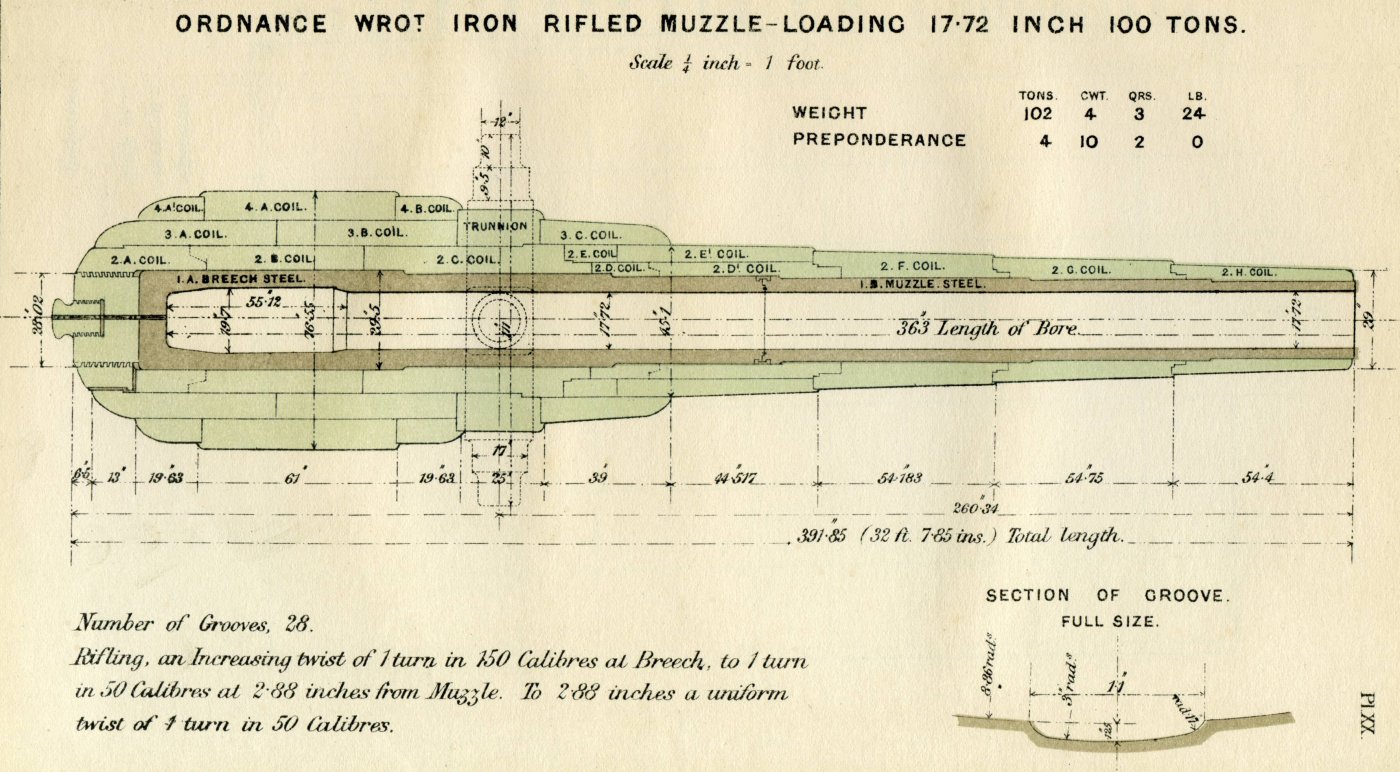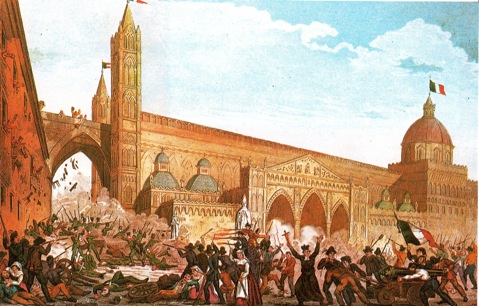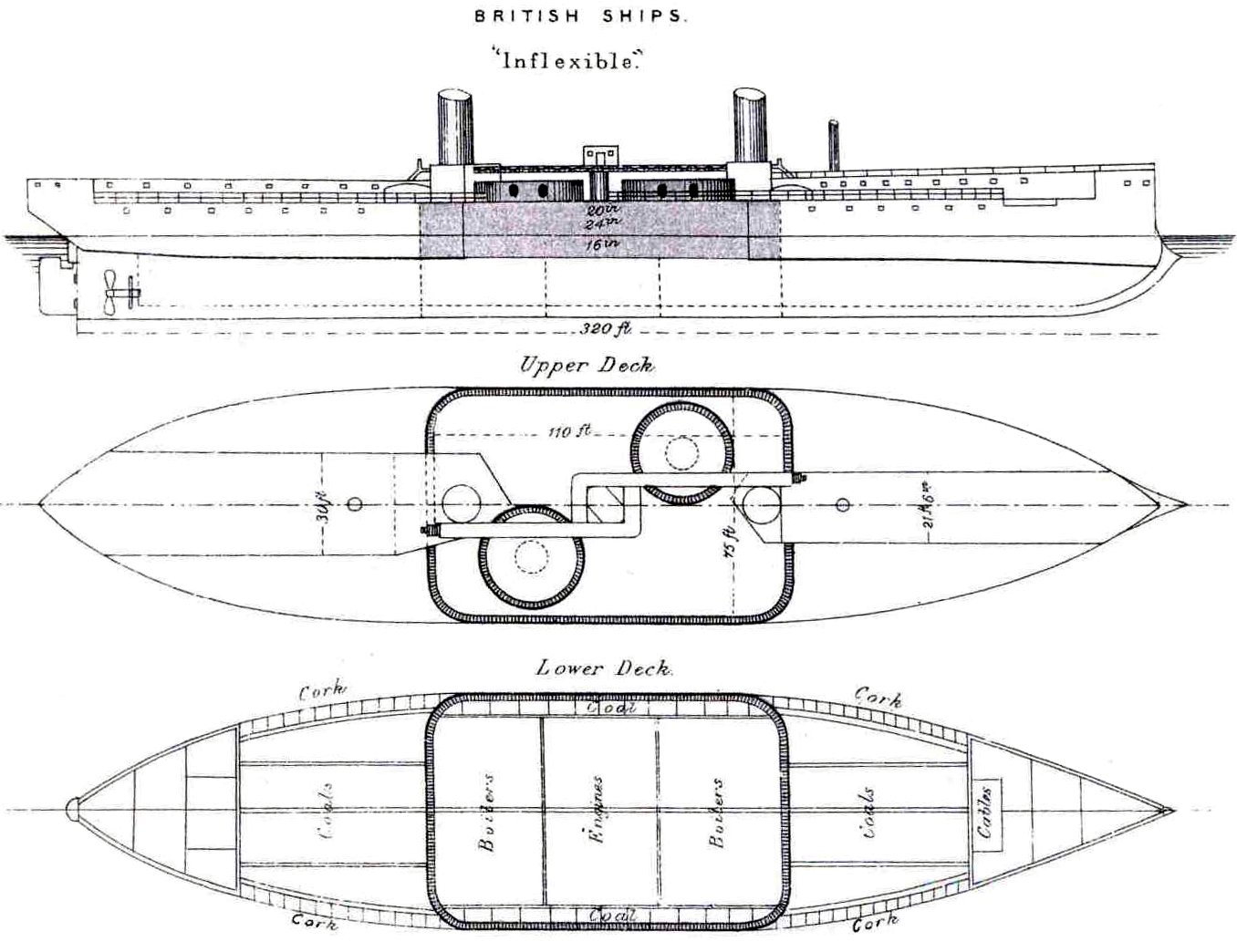|
100 Ton Gun
The 100-ton gun (also known as the Armstrong 100-ton gun) was a rifled muzzle-loading (RML) gun made by Elswick Ordnance Company, the armaments division of the British manufacturing company Armstrong Whitworth, owned by William Armstrong. The 15 guns Armstrong made were used to arm two Italian battleships and, to counter these, British fortifications at Malta and Gibraltar. Origins Around 1870 the largest gun made by UK firms was the 320 mm RML ( rifled, muzzle-loading) gun, with a mass of 38 long tons (38.6 t), firing an projectile capable of piercing of mild steel at . This weapon was adequate for the needs of the time, but the progress of gun technology was very rapid. French industries soon made a 420 mm, 76 tonne gun. This led the Royal Navy to ask for an 80 long ton (81 t) gun. Armstrong, the main British artillery producer, began a project for creation of an even larger weapon, an gun, also called the '100 ton'. Armstrong offered it to the Royal Navy, ... [...More Info...] [...Related Items...] OR: [Wikipedia] [Google] [Baidu] |
Napier Of Magdala Battery
Napier of Magdala Battery is a former coastal artillery battery on the south-western cliffs of the British Overseas Territory of Gibraltar, overlooking the Bay of Gibraltar. It also overlooks Rosia Bay from the north, as does Parson's Lodge Battery from the south. It contains one of two surviving Armstrong 100-ton guns. History In 1883 the British Government installed a single 100-ton gun: a 450 mm rifled muzzle-loading (RML) gun made by Armstrong Whitworth, at the battery by Rosia Bay that they named ''Napier of Magdala Battery'' after Field Marshal Robert Napier, 1st Baron Napier of Magdala, who had served as Governor of Gibraltar from 1876 to 1883. Earlier, in 1879, they had mounted another such gun in Gibraltar at Victoria Battery. These two batteries, together with two in Malta (Cambridge Battery and Fort Rinella), were a response to the Italians having, in 1873, built the battleship ''Duilio'', which was to receive four Armstrong Guns of the same design. The Briti ... [...More Info...] [...Related Items...] OR: [Wikipedia] [Google] [Baidu] |
Palliser Shot
upPalliser shot, Mark I, for 9-inch Rifled Muzzle Loading (RML) gun Palliser shot is an early British armour-piercing artillery projectile, intended to pierce the armour protection of warships being developed in the second half of the 19th century. It was invented by Sir William Palliser, after whom it is named. History Major Palliser's shot, approved 21 October 1867, was an improvement over the ordinary elongated shot of the time. It was adopted for the larger types of rifled muzzle-loading guns rifled on the Woolwich principle (with three rifling grooves). Palliser shot in many calibers stayed in service in the armour-piercing role until phased out of (British) service in 1909 for naval and fortress use, and 1921 for land service. At the Battle of Angamos (8 October 1879) the Chilean ironclad warships fired twenty 250-pound Palliser gunshots against the Peruvian monitor ''Huáscar'', with devastating results. It was the first time that such piercing shells were used in act ... [...More Info...] [...Related Items...] OR: [Wikipedia] [Google] [Baidu] |
Francesco Crispi
Francesco Crispi (4 October 1818 – 11 August 1901) was an Italian patriot and statesman. He was among the main protagonists of the Risorgimento, a close friend and supporter of Giuseppe Mazzini and Giuseppe Garibaldi, and one of the architects of Italian unification in 1860.Nation-building in 19th-century Italy: the case of Francesco Crispi Christopher Duggan, History Today, 1 February 2002 Crispi served as for six years, from 1887 to 1891, and again from 1893 to 1896, and was the first Prime Minister from Southern Italy. Crispi ... [...More Info...] [...Related Items...] OR: [Wikipedia] [Google] [Baidu] |
Suez Canal
The Suez Canal ( arz, قَنَاةُ ٱلسُّوَيْسِ, ') is an artificial sea-level waterway in Egypt, connecting the Mediterranean Sea to the Red Sea through the Isthmus of Suez and dividing Africa and Asia. The long canal is a popular trade route between Europe and Asia. In 1858, Ferdinand de Lesseps formed the Suez Canal Company for the express purpose of building the canal. Construction of the canal lasted from 1859 to 1869. The canal officially opened on 17 November 1869. It offers vessels a direct route between the North Atlantic and northern Indian oceans via the Mediterranean Sea and the Red Sea, avoiding the South Atlantic and southern Indian oceans and reducing the journey distance from the Arabian Sea to London by approximately , or 10 days at to 8 days at . The canal extends from the northern terminus of Port Said to the southern terminus of Port Tewfik at the city of Suez. In 2021, more than 20,600 vessels traversed the canal (an average of 56 per day). T ... [...More Info...] [...Related Items...] OR: [Wikipedia] [Google] [Baidu] |
Italian Ironclad Enrico Dandolo
''Enrico Dandolo'' was the second of two turret ships built for the Italian ''Regia Marina'' (Royal Navy) in the 1870s. They were fitted with the largest guns available, rifled, muzzle-loading guns, and were the largest, fastest and most powerful ships of their day.Silverstone, p. 285 ''Enrico Dandolo'' was built in La Spezia, with her keel laid in January 1873 and her hull launched in July 1878. Construction was finally completed in April 1882 when the ship, named for the 41st Doge of Venice, was commissioned into the Italian fleet. ''Enrico Dandolo'' spent much of her career in the Active Squadron of the Italian fleet, primarily occupied with training exercises. She was heavily modernized in 1895–1898, receiving a new battery of fast-firing guns in place of the old 17.72 in guns. The ship served in the Reserve Squadron after 1905, and then became a gunnery training ship. During the Italo-Turkish War of 1911–1912, ''Enrico Dandolo'' was among the few ships of th ... [...More Info...] [...Related Items...] OR: [Wikipedia] [Google] [Baidu] |
Italian Ironclad Duilio
''Duilio'' was the lead ship of the of ironclad warship, ironclad turret ships built for the Italian ''Regia Marina'' (Royal Navy). Named for the Roman admiral Gaius Duilius, the ship was laid down in January 1873, was launched in May 1876, and was completed in January 1880. She was armed with a main battery of four guns, then the largest gun afloat, and she was capable of a top speed of around . ''Duilio''s career was uneventful. She spent her first two decades in service with the Active and Reserve Squadrons, primarily tasked with training maneuvers and exercises. She was withdrawn from front-line duty in 1902 and thereafter employed as a training ship, though this role only lasted until 1909 when she was converted into a floating oil tank and renamed ''GM40''. The ship's ultimate fate is unknown. Design The s were designed by the noted Italian naval architect Benedetto Brin; they were revolutionary warships at the time they were designed, being the first ironclad battle ... [...More Info...] [...Related Items...] OR: [Wikipedia] [Google] [Baidu] |
Italia
Italy ( it, Italia ), officially the Italian Republic, ) or the Republic of Italy, is a country in Southern Europe. It is located in the middle of the Mediterranean Sea, and its territory largely coincides with the homonymous geographical region. Italy is also considered part of Western Europe, and shares land borders with France, Switzerland, Austria, Slovenia and the enclaved microstates of Vatican City and San Marino. It has a territorial exclave in Switzerland, Campione. Italy covers an area of , with a population of over 60 million. It is the third-most populous member state of the European Union, the sixth-most populous country in Europe, and the tenth-largest country in the continent by land area. Italy's capital and largest city is Rome. Italy was the native place of many civilizations such as the Italic peoples and the Etruscans, while due to its central geographic location in Southern Europe and the Mediterranean, the country has also historically been home ... [...More Info...] [...Related Items...] OR: [Wikipedia] [Google] [Baidu] |
HMS Inflexible (1876)
HMS ''Inflexible'' was a Victorian era, Victorian Ironclad warship, ironclad battleship carrying her main armament in centrally placed gun turret, turrets. The ship was constructed in the 1870s for the Royal Navy to oppose the perceived growing threat from the Italian ''Regia Marina'' in the Mediterranean. The Italian Navy had started constructing a pair of battleships, and , equipped with four Armstrong-Whitworth, Armstrong 17.7-inch (450 mm) guns weighing 100 tons each. These were superior to the armament of any ship in the British Mediterranean Squadron, and ''Inflexible'' was designed as a counter to them. ''Inflexible'' mounted larger guns than those of any previous British warship and had the thickest armour ever to be fitted to a Royal Navy ship. Controversially, she was designed so that if her un-armoured ends should be seriously damaged in action and become water-logged, the buoyancy of the armored citadel, armoured centre section of the ship would keep her afloat ... [...More Info...] [...Related Items...] OR: [Wikipedia] [Google] [Baidu] |
Duilio-class Ironclad
The ''Duilio'' class was a pair of ironclad turret ships built for the Royal Italian Navy (''Regia Marina'') in the 1870s and 1880s. The two ships, and , were fitted with the largest guns available, rifled muzzle-loading guns, and were the largest, fastest and most powerful ships of their day.Silverstone, p. 285 To save weight on such large vessels, the ship's designer, Benedetto Brin adopted a radical solution for the time: he reserved armor only for the central portion of the ship where it protected the ships' engines and ammunition magazines, while the rest of the hull were extensively sub-divided with watertight compartments. Both ships had uneventful careers. They spent the majority of their time in service with the Active and Reserve Squadrons of the main Italian fleet. There, they were primarily occupied with conducting training exercises. In 1895–1898, ''Enrico Dandolo'' was heavily reconstructed, but the excessive cost of the modernization prevented ''Duilio'' fro ... [...More Info...] [...Related Items...] OR: [Wikipedia] [Google] [Baidu] |
Battleship
A battleship is a large armored warship with a main battery consisting of large caliber guns. It dominated naval warfare in the late 19th and early 20th centuries. The term ''battleship'' came into use in the late 1880s to describe a type of ironclad warship,Stoll, J. ''Steaming in the Dark?'', Journal of Conflict Resolution Vol. 36 No. 2, June 1992. now referred to by historians as pre-dreadnought battleships. In 1906, the commissioning of into the United Kingdom's Royal Navy heralded a revolution in the field of battleship design. Subsequent battleship designs, influenced by HMS ''Dreadnought'', were referred to as "dreadnoughts", though the term eventually became obsolete as dreadnoughts became the only type of battleship in common use. Battleships were a symbol of naval dominance and national might, and for decades the battleship was a major factor in both diplomacy and military strategy.Sondhaus, L. ''Naval Warfare 1815–1914'', . A global arms race in battleship cons ... [...More Info...] [...Related Items...] OR: [Wikipedia] [Google] [Baidu] |
Regia Marina
The ''Regia Marina'' (; ) was the navy of the Kingdom of Italy (''Regno d'Italia'') from 1861 to 1946. In 1946, with the Italian constitutional referendum, 1946, birth of the Italian Republic (''Repubblica Italiana''), the ''Regia Marina'' changed its name to ''Marina Militare'' ("Military Navy"). Origins The ''Regia Marina'' was established on 17 March 1861 following the proclamation of the formation of the Kingdom of Italy (1861–1946), Kingdom of Italy. Just as the Kingdom was a unification of various states in the Italian Peninsula, Italian peninsula, so the ''Regia Marina'' was formed from the navies of those states, though the main constituents were the Real Marina (Kingdom of the Two Sicilies), navies of the former kingdoms of Kingdom of Sardinia, Sardinia and Kingdom of Naples, Naples. The new Navy inherited a substantial number of ships, both sail- and steam-powered, and the long naval traditions of its constituents, especially those of Sardinia and Naples, but also ... [...More Info...] [...Related Items...] OR: [Wikipedia] [Google] [Baidu] |
Unification Of Italy
The unification of Italy ( it, Unità d'Italia ), also known as the ''Risorgimento'' (, ; ), was the 19th-century Political movement, political and social movement that resulted in the Merger (politics), consolidation of List of historic states of Italy, different states of the Italian Peninsula into a Proclamation of the Kingdom of Italy, single state in 1861, the Kingdom of Italy. Inspired by the rebellions in the 1820s and 1830s against the outcome of the Congress of Vienna, the unification process was precipitated by the Revolutions of 1848, and reached completion in 1871 after the Capture of Rome and its designation as the capital of the Kingdom of Italy. Some of the states that had been targeted for unification (''Italian irredentism, terre irredente'') did not join the Kingdom of Italy until 1918 after Italy defeated Austria-Hungary in the First World War. For this reason, historians sometimes describe the unification period as continuing past 1871, including activities ... [...More Info...] [...Related Items...] OR: [Wikipedia] [Google] [Baidu] |








